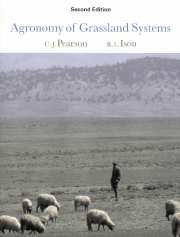Book contents
- Frontmatter
- Contents
- Preface
- 1 Overview: perspectives on grassland systems
- 2 The emergence of grassland systems
- 3 Generation
- 4 Vegetative growth
- 5 Flowering and seed production
- 6 Mineral nutrition
- 7 Herbage quality and animal intake
- 8 Grassland – animal interactions and management
- 9 Grassland systems design
- References
- Index
1 - Overview: perspectives on grassland systems
Published online by Cambridge University Press: 05 June 2012
- Frontmatter
- Contents
- Preface
- 1 Overview: perspectives on grassland systems
- 2 The emergence of grassland systems
- 3 Generation
- 4 Vegetative growth
- 5 Flowering and seed production
- 6 Mineral nutrition
- 7 Herbage quality and animal intake
- 8 Grassland – animal interactions and management
- 9 Grassland systems design
- References
- Index
Summary
Recent understandings from the ‘new biology’ and other areas of research are challenging the ways in which grassland systems have historically been ‘seen’. When we say ‘seen’ we mean the way we think about, and use language to talk about ‘grassland systems’. Most texts on agronomy or grasslands will not address these issues. Historically they have taken the perspective that certain ‘real types’ of grassland systems exist that can be described and classified and that these understandings can be used as a basis for intervention and change. We start from a different perspective. In recent years there has been growing acceptance of several complex, seemingly intransigent problems, often collectively referred to as environmental problems, or problems of sustainable development. Specific examples, related to grasslands, include the loss of organic matter from soils, loss of biodiversity, rangeland degradation and desertification and the contribution of grasslands to ‘greenhouse effects’. The perspective of this book is that if we are to manage these complex issues, there is a need firstly to look at how we think about the issues and the ways in which historically we have chosen to manage. We recognize that many of the issues arise because of our own historical practices, and that more of the same practices will not necessarily be a good thing.
The concept of perspective is important. We recognize from daily life that none of us have the same history, that we all have different and unique experiences, and as a consequence we all have our own perspective on things and events.
- Type
- Chapter
- Information
- Agronomy of Grassland Systems , pp. 1 - 17Publisher: Cambridge University PressPrint publication year: 1997
- 2
- Cited by



